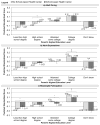School-Based Health Centers and School Connectedness
- PMID: 30506695
- PMCID: PMC6287272
- DOI: 10.1111/josh.12707
School-Based Health Centers and School Connectedness
Abstract
Background: Improvements in health behaviors and academic outcomes have been associated with school-based health centers (SBHCs). However, underlying mechanisms for these associations have been largely unexamined, particularly among lower-income youth. The current study examines the relationship between SBHCs and school connectedness and whether this relationship differs by youths' socioeconomic status (SES).
Methods: Student-level cross-sectional data from 503 traditional high schools in California were analyzed using multilevel regression models. California Healthy Kids Survey 2013-2014 data included information on 3 dimensions of school connectedness and demographic characteristics including SES as measured by parental education. School-level demographic data was gathered from publicly available sources.
Results: Although no significant relationship between SBHCs and any of the school connectedness dimensions emerged, there were significant cross-level interactions between SBHCs and parent education. SBHCs were more positively associated with school connectedness (adult caring, adult expectations, and meaningful participation) among lower SES students compared to students with higher SES.
Conclusions: SBHCs may be particularly effective in affecting school connectedness among lower income youth populations. This has wide ranging implications with regards to planning (eg, careful selection of where SBHCs can be most effective), and future research (eg, examining the effectiveness of specific SBHC strategies that support connectedness).
Keywords: parental education; school connectedness; school-based health centers; socioeconomic status.
© 2018, American School Health Association.
Figures

Similar articles
-
School-Based Health Centers and Adolescent Substance Use: Moderating Effects of Race/Ethnicity and Socioeconomic Status.J Sch Health. 2017 Nov;87(11):850-857. doi: 10.1111/josh.12559. J Sch Health. 2017. PMID: 29023835 Free PMC article.
-
Voices from Minority Youth on Help-Seeking and Barriers to Mental Health Services: Partnering with School-Based Health Centers.Ethn Dis. 2018 Sep 6;28(Suppl 2):437-444. doi: 10.18865/ed.28.S2.437. eCollection 2018. Ethn Dis. 2018. PMID: 30202197 Free PMC article.
-
School-Based Health Centers and School Attendance in Rural Areas.JAMA Netw Open. 2025 May 1;8(5):e2510083. doi: 10.1001/jamanetworkopen.2025.10083. JAMA Netw Open. 2025. PMID: 40358944 Free PMC article.
-
School-based health centers in an era of health care reform: building on history.Curr Probl Pediatr Adolesc Health Care. 2012 Jul;42(6):132-56; discussion 157-8. doi: 10.1016/j.cppeds.2012.03.002. Curr Probl Pediatr Adolesc Health Care. 2012. PMID: 22677513 Free PMC article. Review.
-
The Influence of School-Based Health Centers on Adolescents' Youth Risk Behaviors.J Pediatr Health Care. 2016 May-Jun;30(3):e1-9. doi: 10.1016/j.pedhc.2015.07.005. Epub 2015 Aug 19. J Pediatr Health Care. 2016. PMID: 26298683 Review.
Cited by
-
Contextualizing the Association Between School Climate and Student Well-Being: The Moderating Role of Rurality.J Sch Health. 2021 Jun;91(6):463-472. doi: 10.1111/josh.13026. Epub 2021 Apr 5. J Sch Health. 2021. PMID: 33821509 Free PMC article.
-
School-Based Health Centers, Access to Care, and Income-Based Disparities.JAMA Netw Open. 2023 Sep 5;6(9):e2334532. doi: 10.1001/jamanetworkopen.2023.34532. JAMA Netw Open. 2023. PMID: 37721750 Free PMC article.
-
Advancing health equity by addressing social determinants of health: Using health data to improve educational outcomes.PLoS One. 2021 Mar 17;16(3):e0247909. doi: 10.1371/journal.pone.0247909. eCollection 2021. PLoS One. 2021. PMID: 33730057 Free PMC article.
-
Adolescent Connectedness: A Scoping Review of Available Measures and Their Psychometric Properties.Front Psychol. 2022 May 18;13:856621. doi: 10.3389/fpsyg.2022.856621. eCollection 2022. Front Psychol. 2022. PMID: 35664205 Free PMC article.
-
The Evidence on School-Based Health Centers: A Review.Glob Pediatr Health. 2019 Feb 19;6:2333794X19828745. doi: 10.1177/2333794X19828745. eCollection 2019. Glob Pediatr Health. 2019. PMID: 30815514 Free PMC article. Review.
References
-
- Guide to Community Preventive Services. Promoting health equity through education programs and policies: School-based health centers. 2015 http://www.thecommunityguide.org/healthequity/education/schoolbasedhealt..., 2016.
-
- Strolin-Goltzman J. The relationship between school-based health centers and the learning environment. J Sch Health. 2010;80(3):153–159. - PubMed
-
- Strolin-Goltzman J, Sisselman A, Melekis K, Auerbach C. Understanding the relationship between school-based health center use, school connection, and academic performance. Health Soc Work. 2014;39(2):83–91. - PubMed
-
- Centers for Disease Control and Prevention. Atlanta, GA: US Department of Health and Human Services; 2009. School connectedness: Strategies for increasing protective factors among youth.
-
- Thompson D, Iachan R, Overpeck M, Ross J, Gross L. School connectedness in the health behavior in school-aged children study: The role of student, school, and school neighborhood characteristics. J Sch Health. 2006;76(7):379–386. - PubMed
Publication types
MeSH terms
Grants and funding
LinkOut - more resources
Full Text Sources
Medical

